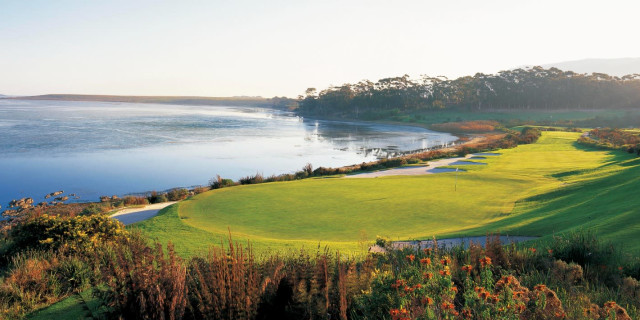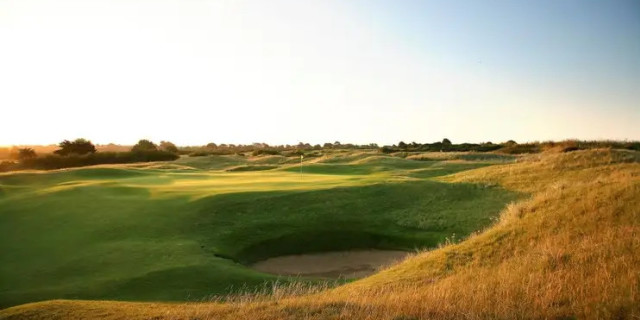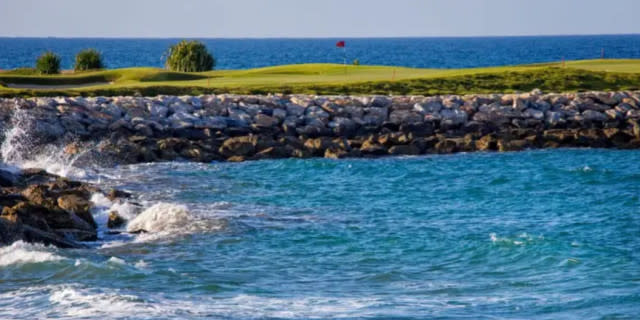
10 of the Best - Courses in Oxfordshire
OXFORDSHIRE is one of the most beautiful counties in England, located close to London, with the Cotswolds to the west and the Chilterns to the east. It is, by and large, an agricultural county, with thousands of acres of rolling countryside and farmland. The county town of Oxford is, of course, one of the most famous university towns on the planet.
It is the sixth most popular county in Britain for foreign tourists, who flock to Oxford to see the ancient university buildings, as well as visiting such tourist attractions as Blenheim Palace, with its magnificent gardens designed by Capability Brown. Other popular destinations include Henley-on-Thames, Chipping Norton and Banbury.
With its fabulous rolling countryside, it should come as no surprise to learn that Oxfordshire is also home to some fine golf course. We highlight 10 of the best for you.
The Oxfordshire
Par 72, 6,826 yards, parkland
Green fee £70, winter £50
Developed in 1992, the spectacular Oxfordshire has hosted the Benson & Hedges International and the WGC Andersen Consulting. It was designed by Rees Jones, who redesigned Torrey Pines and Bethpage in the USA. It features four lakes and 135 bunkers. The third measures 485 yards and is a par four - yes, a par four. It is a dogleg to the right, where the drive can either be played to the left of the bunker on the corner of the fairway or big hitters can carry the fairway bunker to leave a shorter approach. The fourth is a great par five measuring 575 yards. Your drive must avoid the bunker down the right hand side. A well struck second shot is then required to carry the huge fairway bunker and rough. This will leave you a short iron into a green guarded by a bunker on the left and water on the right. The 10th measures 445 yards and plays downhill. Your drive must avoid the fairway bunker and the real challenge comes with the approach, with bunkers to the left of the green and a large lake cutting into the right. The signature hole is the 600-yard par-five 17th hole. A huge lake runs all the way down the left and guards the green. A straight drive is required to avoid the large bunker on the right and the water on the left. Low handicappers then have the option of going for a big hit across the lake - get it right and you set up a birdie; come up short and you could run up a cricket score. Alternatively, you can play around the edge of the lake. There are plenty of bunkers surrounding the sloping green. Click here for a Feature Review.
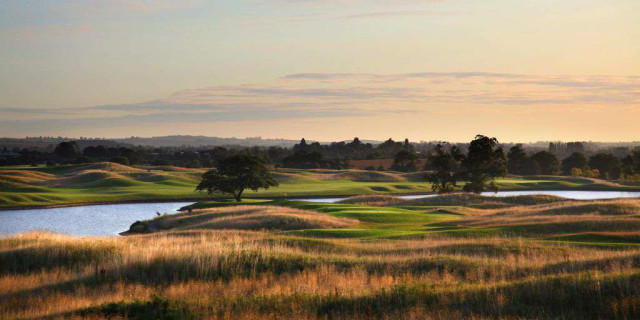
Frilford Heath Golf Club (Red)
Par , 7.015 yards, heathland
Green fee £100
Frilford's oldest and most prestigious course, the Red, was laid out in 1908 by JH Taylor, the five-time Open champion, and it is a cracker. There are two more courses here that also well worth a visit. The greens and fairways are as good as you will find anywhere, with hundreds of trees waiting to swallow up wayward drives and approach shots. The first hole is par four. It measures 389 yards and is the sort of golf hole that makes you swallow hard. It is a gentle dogleg with trees right and left and a narrow fairway. The approach is to an elevated green with a bunker right and shrubs and trees at the back. The eighth is a cracking par four of 469 yards. It is another gentle dogleg and again the trees on both sides make it feel quite claustrophobic, but there is more room than you think. You play to another elevated green, with a run-off area, so think long and hard about club selection, because you don't want to go long. The 10th is a par five measuring 551 yards and cuts its way through an avenue of trees. There is a well-placed bunker on the right, two more where your second shot will land and a further two bunkers protecting the green - and, once again, go through the green and you will be in deep trouble. The 17th hole, at 405 yards, may just be the best hole on the course. A straight drive is essential to avoid two bunkers on the right. There is also a long, narrow bunker about 50 yards short of the green and two more guarding it
Oxford Golf Club
Par 70, 6,380 yards, parkland
Green fee £17.50-£30 (depends on tee-time)
Oxford Golf Club was designed in 1922 by the legendary Harry Colt. Known back then as the Oxford University Golf Club, it became Southfield Golf Club in 1945 when it became managed predominantly by the City club. In 2014 Southfield Golf Club changed its name to Oxford Golf Club. The third hole is a 402-yard par four. It has an elevated tee and you drive downhill towards a stream 290 yards away and then play up a slope to a well-protected green. The seventh is just 327 yards, but it is a stunning hole with an elevated tee that offers great views of the surrounding Oxfordshire countryside, with mature willow and poplar trees. The 10th hole is a 559-yard par five featuring a large oval green that is guarded by two bunkers and surrounded by hedges on the left and woods at the back. The 11th, a 403-yard hole that marks the start of a difficult stretch, calls for an accurate drive followed by an approach to a green which has a stream running along the front. The 18th is another par five, played from a raised tee to an open fairway. The green is protected by lakes front, side and back. A terrific risk-reward hole.
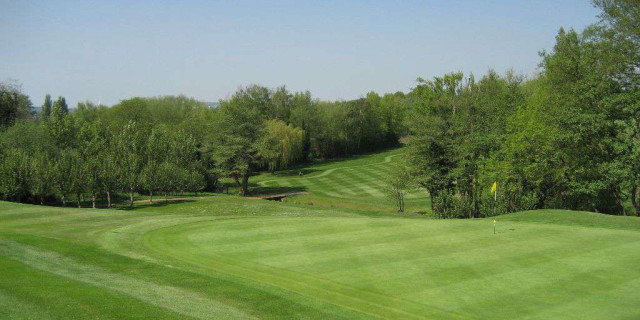
Heythrop Park Golf Club
Par 72, 7,088 yards, parkland
Green fee £40
The Bainbridge Course at Heythrop Park was redesigned in 2009 by Tom MacKenzie the golf course architect. The course is located in the 440-acre Heythrop estate in the heart of Oxfordshire. The first is a 457-yard par four calling for a drive threaded between 300- year-old beech trees on the right and a Jesuit graveyard on the left to set up an approach to a raised green protected by a bunker short and on the left-hand side of the putting surface. The beech trees down the right were planted in straight lines to create an avenue. The eighth hole, measuring 414 yards, sweeps uphill over water and then goes to the right towards a raised green protected by a bunker. You will need to hit your drive at least 240 yards to get a clear view of the green. The 203-yard par-three 13th requires an accurate tee shot over a stream to a green cut into the side of a hill. The stream is lined with Cotswold stone taken from around from the estate. The 18th measures 596 yards and is arrow straight, with the green sitting in the shadow of the main house, which forms a good aiming point. The drive and the second shot should be aimed at the front entrance while the approach is difficult to judge because of the absence of bunkers around the green, which is guarded by a series of grass hollows. Feature Review.
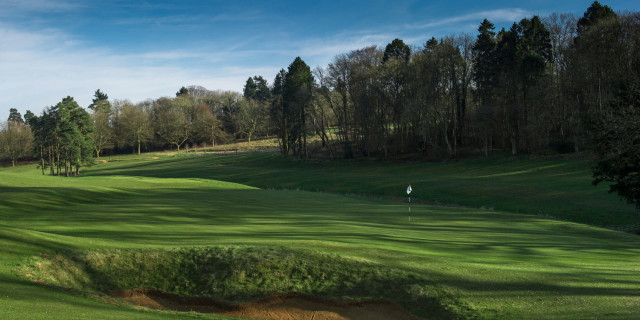
Witney Lakes Golf Club
Par 71, 6,500 yards, parkland
Green fee £22, winter £17
Witney Lakes was designed by internationally renowned course architect Simon Gidman, who has designed golf courses in India, Germany, Ireland and throughout Europe as well as in the UK. It features a number of dog-leg holes, and is a really good test. It opens with a tough par four measuring 440 yards. It is a dog leg to the right with a bunker on the corner of the dog leg. Go too far left and a mound comes into play. The green slopes from front to back and is well protected by bunkers, with a hedge at the back of the green for anybody who goes too long. The seventh measures 441 yards and features a lateral hazard and out of bounds all the way down the right. Go too far left and your approach will be blocked out by trees. Your second shot needs to carry a ditch and hawthorn tree. The 13th is par five of 485 yards that requires a strategic approach. It is a slight dog leg left with out of bounds all the way down the left. A tee shot hit too far right could find the bunker or even the lake on the 8th hole. Depending on the wind, it is either a lay up short of the bunkers or a long second to the green. The green is protected by bunkers left and a water hazard right. The course closes with a 408-yard par four, with bunkers and out of bounds on the left. Bail out right and a bunker and trees will swallow up your golf ball. Be careful not to go beyond the flag with your approach as it will leave you with a fast downhill putt.
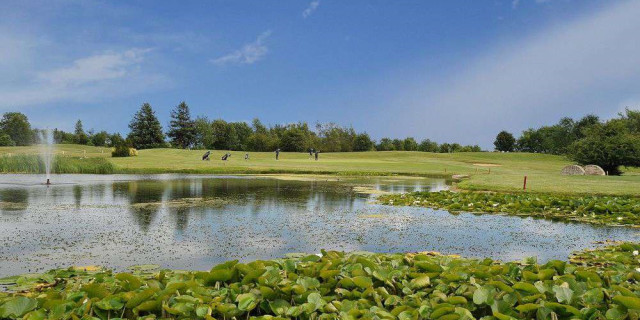
Huntercombe Golf Club
Par 70, 6,300 yards, parkland
£65, winter £50
Huntercombe was designed by Wlllie Park in 1901 as a heathland course, although the fairways are now mostly bounded by mature trees and woodland. There is plenty of gorse but only 13 bunkers, but the course does feature more than 100 grass hazards. The second is a par four measuring 429 yards. You can open your shoulders here but beware that you don't hook your drive out of bounds. The fairway slopes from right to left so aim to the right. With your approach, be careful to avoid a bank running across the front of the green. Some drop their approach 10-yards short centre/right and run down. Don't miss the green left, as the steep bank takes no prisoners. The 12th measures 435 yards, with a drive that is fairly simple – the hole also features one of the course's rare bunkers, located just short of the green, and ideally placed to swallow up any approach that it is not perfectly struck. If you go slightly too far, your ball will roll over the sloping green into the rough beyond. The 18th, a 403-yard par four, is an excellent finishing hole calling for the ideal drive to be struck slightly left of centre. If you go even slightly right you will end up in the bunker of be blocked out by overhanging branches for your second shot. The green is protected by clump of gorse that has to be carried.
The Wychwood Golf Club
Par 72, 6,844 yards, parkland
Green fee £30
The Wychwood is located in 170 acres of countryside, with not a house to be seen for miles around. The second is a 420-yard par four, with fairway bunkers left and right. The drive is played uphill, which means the hole plays rather longer than its length. The large green is protected by three deep bunkers. Club selection for the approach shot can be as much as three clubs different depending on pin location so make sure you have enough club in your hands. The seventh is a gentle dogleg to the left. It only measures 337 yards, but there are trees on the left and a lake on the right. Take a rescue club from the tee for position before an approach to a small green, well guarded by bunkers and rough. There is dead ground between the first bunker and the green. The 13th, at 401 yards, could be unlucky for some. It calls for a drive hit left of centre before an approach that is further than it looks as there is dead ground between the grass bunker and the green. Go left with your second shot and a watery grave awaits. There are also trees on both sides of the fairway and behind the green. The finishing hole is a classic risk-and-reward par four of just 275 yards. Catch your drive properly and you will find the green to set up a closing birdie, but five birdies and a greenside lake mean it could easily all end in tears. Oh yes, and the green has two tiers – find the wrong level and you will almost certainly be finishing with three putts.
Hadden Hill Golf Club
Par 71, 6,563 yards, parkland
Green fee £20
The front nine at Hadden Hill opened in May 1990, with the back nine opening for business a year later. It was designed by Michael Morley and features more than 30 miles of underground drainage and each bunker has a drain underneath it. The club also has a six-hole par-three course. Hadden Hill opens with a 540-yard par five with out of bounds running down the left. The fairway, which is well protected by trees, slopes from right to left, so the ideal drive should be aimed at a solitary poplar on the right side. The slope will bring the ball back into the middle. You must avoid the bunker situated 85 yards from the green with your second, and your approach is to a putting surface guarded by two further bunkers. The fifth is 394 yards long and looks innocuous enough but it needs care – there are lateral water hazards on both sides of the fairway, which slopes gently downhill. There are also trees on the right side. Hit your approach too far right and it will disappear into a ditch. The 11th, measuring 402 yards, offers wonderful views of the surrounding countryside. Hit straight on this hole to avoid the water hazard to the left. There are trees on both sides and the green is guarded by three bunkers. The closing hole is a 517-yard par five, with two bunkers to right side of a the uphill fairway. The hole then moves downhill, from left to right, with a greenside bunker to the right. The green, which is small, is below the level of the fairway.
The Springs Golf Club
Par 72, 6,470 yards, parkland
Green fee £30
The Springs, which was designed by former Ryder Cup player Brian Huggett, is a glorious parkland course with hundreds of oak trees, plenty of water and some very challenging sleepered bunkers. The signature hole is the eighth, a testing 184-yard par three. Much depends on the direction and strength of the wind - you can hit anything from a five or six iron to a three wood. The magnificent green is surrounded by water and bunkers so anything drifting offline will find a watery grave or have you scrambling to save par. The ninth is a 496-yard par five. The fairway is fairly generous, but there is a stream to the left and a huge lake looms on the right side (it also comes into play on the 10th), so keep your drive to the left. If you decide to go for the green in two, a bunker to the left must be avoided. The 17th, at 290 yards, is a terrific par four. Do you go for the green or do you play safe? It is a gentle dog leg but you can see the green from the tee - the only problem is that there is a lake to be cleared just in front of the putting surface. Find the greenside bunker and the danger is that you hit it too hard and finish in the water. The 18th is a really good finishing hole, measuring 410 yards. It is a dogleg that not only features tall, mature oaks on both sides of the fairway but also has a copse of trees that split the fairway in two. You have to pick your line and commit to it or you will have no chance at all of getting home in two.
Cherwell Edge Golf Club
Par 70, 6,080 yards, parkland
Green fee £25
Cherwell Edge is a mature tree-lined course set in scenic countryside and offering many splendid views, as well as being a good challenge for golfers of all standards. The third is a par five measuring 520 yards, with trees down the right. There is plenty of room on the left but the best line is towards the right centre of the fairway, so you should flirt with the trees. Keep out of trouble from the tee and you then have a problem with your second shot as a copse of trees lies in the middle of the fairway, about 80 yards from the green - get too close and you will have no approach shot. The ninth is a superb par four,measuring 415 yards - once again, trees encroach on the right side and your drive also has to carry water to set up an approach to a smallish, well-protected green. The 10th is a 337-yard par four which looks straightforward enough, but go left and you will find a watery grave, and if you miss the water there is a perfectly placed bunker waiting to swallow up the perfect drive. Position is everything on this hole. The 17th is a fantastic par five that measures 485 yards. There are two fairways, divided by a huge avenue of trees. If you choose to opt for the left-hand fairway you make the hole slightly shorter, but you will need yo hit your third shot over the trees to find the green - go right to give yourself the best approach.
Related Content: Oxfordshire Courses

